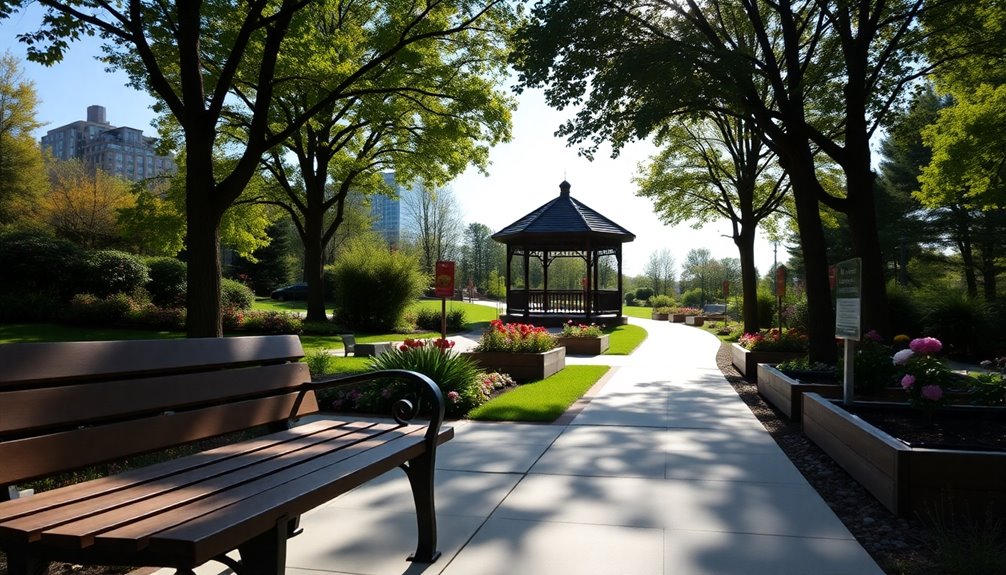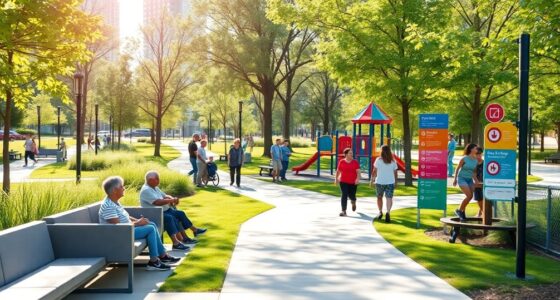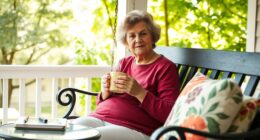To enhance mobility for seniors, consider these practical age-friendly design ideas: optimize pathways by widening hallways and minimizing obstacles, improve lighting with natural sources and warm fixtures, and choose ergonomic furniture that supports easy access. Modify kitchens with adjustable countertops and easy-to-grip handles, and integrate smart home technologies for convenience. Create outdoor spaces with accessible paths and sturdy handrails. These modifications can make a real difference in quality of life, and there's even more to explore!
Key Takeaways
- Ensure hallways and doorways are at least 36 inches wide to accommodate mobility aids and enhance navigation.
- Install grab bars in bathrooms to significantly reduce fall risks and provide stability when entering or exiting showers or bathtubs.
- Utilize contrasting colors for walls and floors to improve visibility and help seniors navigate their living spaces safely.
- Incorporate smart home technologies like voice-activated assistants and automated lighting to simplify daily tasks and enhance safety.
- Create clear outdoor pathways with gentle slopes and handrails to ensure easy navigation for seniors with mobility challenges.
Importance of Age-Friendly Design for Seniors
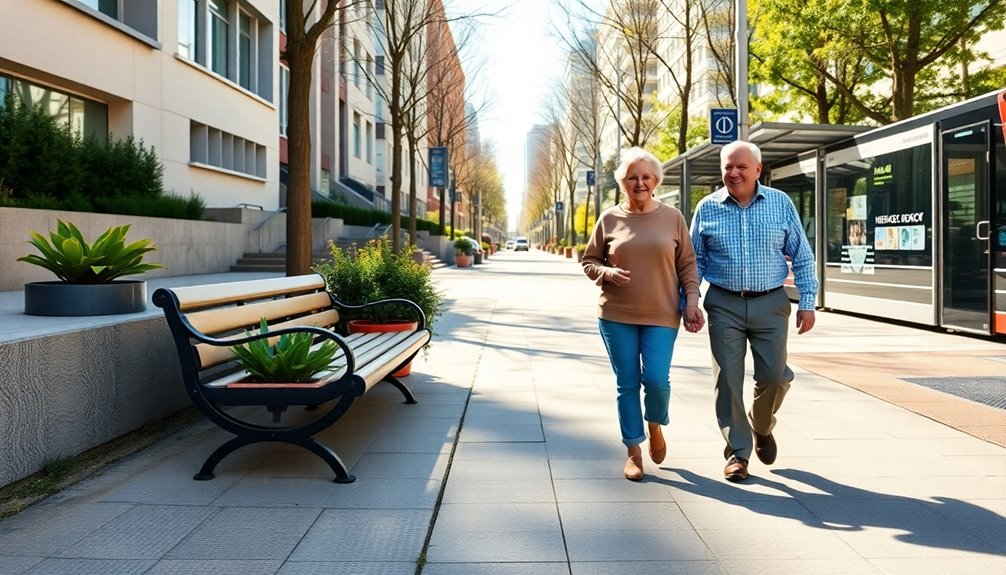
Creating an age-friendly environment is essential for enhancing the quality of life for seniors. With age-friendly design, you can address mobility challenges that many face, allowing them to navigate their homes safely and independently.
Over 75% of seniors prefer aging in place, so implementing features like wider doorways and no-step entries greatly boosts safety and comfort. These modifications reduce fall risks, a leading cause of injury among older adults.
Additionally, smart home technologies, such as motion-activated lighting, can simplify daily tasks and enhance overall well-being. By accommodating both physical limitations and cognitive changes, age-friendly design fosters a sense of autonomy, making it easier for seniors to enjoy their living spaces while maintaining independence and dignity.
Incorporating home improvement strategies can further optimize living spaces to meet the unique needs of seniors.
Assessing Home Accessibility Needs
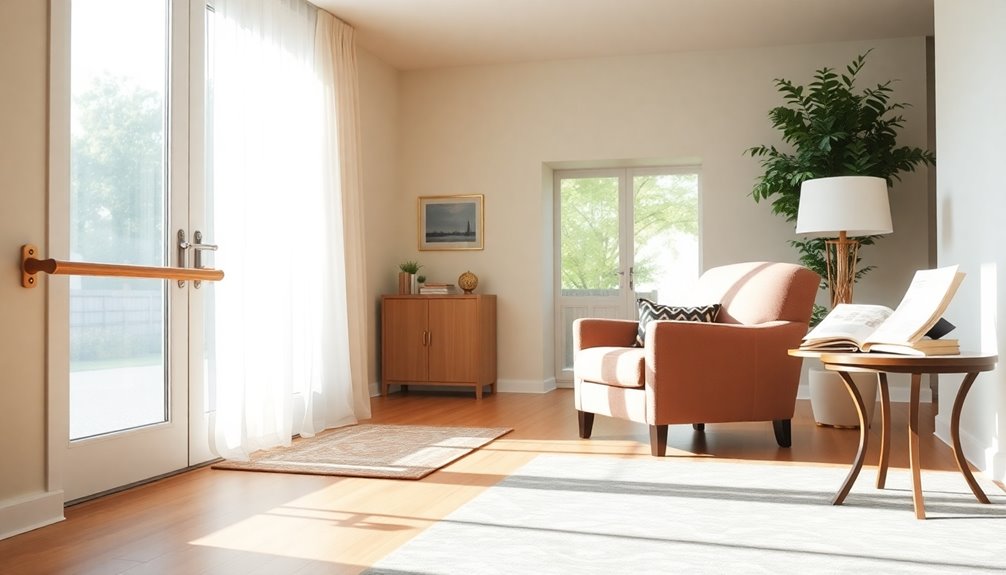
To create a safe home environment for seniors, start by conducting a thorough home assessment.
Identify any barriers that could hinder mobility, like stairs and narrow doorways, and consider individual needs for accessibility.
This checklist will help you pinpoint necessary modifications to enhance comfort and safety. Additionally, consider seeking professional counseling to support seniors emotionally as they navigate changes in their living environment.
Home Assessment Checklist
Evaluating your home for accessibility needs is vital for maintaining independence and safety as you or your loved ones age.
Start with a thorough home assessment to guarantee all entryways have step-free access. Check that doorways and hallways are at least 32 inches wide, allowing for walkers or wheelchairs. Educational toys can promote fine motor skills, which can be beneficial for maintaining dexterity in seniors. Additionally, consider incorporating wood-burning stoves for an efficient and sustainable heating solution that enhances comfort during colder months.
Adequate lighting is essential—pay special attention to hallways and stairways to reduce fall risks. Identify and remove tripping hazards like loose rugs and clutter to maintain clear pathways throughout your home.
For a tailored evaluation, consider consulting a Certified Aging in Place Specialist (CAPS) who can provide insights specific to your mobility needs and home layout. Additionally, implementing age-friendly design features can significantly improve accessibility and comfort in your living space.
Taking these steps can markedly enhance safety and comfort.
Identify Individual Needs
How can you guarantee that your home meets your specific accessibility needs as you age? Start with a thorough home assessment to identify individual needs and mobility challenges.
Involve the senior in this process to confirm modifications align with their lifestyle. Use checklists or questionnaires designed for home accessibility to pinpoint areas needing enhancement. Additionally, recognizing the emotional dysregulation common in individuals facing significant life changes can be vital for understanding their needs. Understanding the importance of monitoring credit card statements can also be beneficial for managing finances related to home modifications.
Consider collaborating with a Certified Aging in Place Specialist (CAPS) for expert advice on effective modifications. Additionally, incorporating self-care practices into daily routines can significantly enhance overall well-being and mobility.
- Assess existing health conditions
- Evaluate physical limitations
- Focus on daily activities requiring mobility support
- Regularly reassess the home environment
Creating Clear Pathways for Navigation
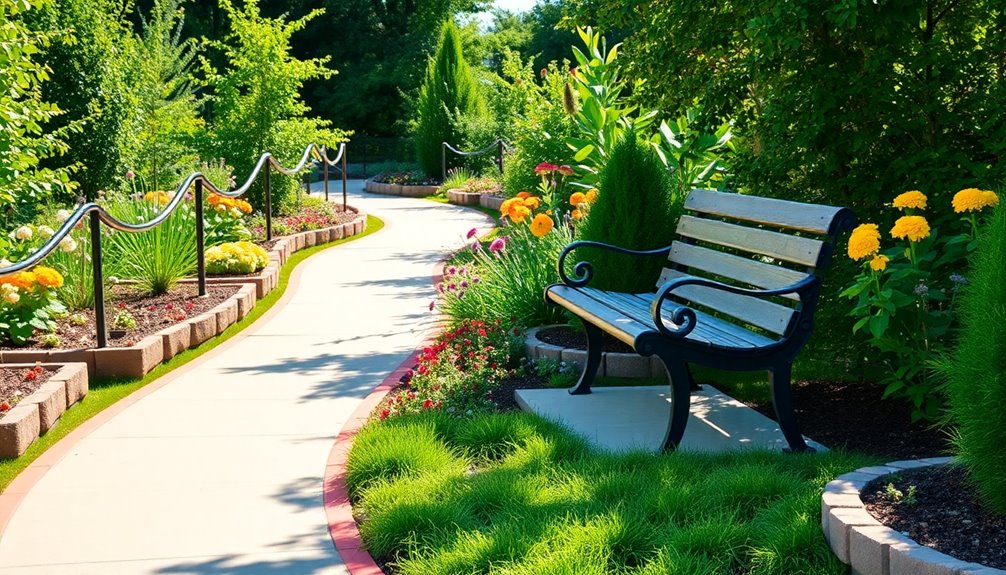
Creating a safe and accessible home environment for seniors hinges on clear pathways for navigation.
To enhance mobility, guarantee hallways and doorways are at least 36 inches wide, allowing easy access for walkers and wheelchairs.
Arrange furniture to create clear pathways, minimizing potential obstacles that could lead to falls.
Use contrasting colors for walls and floors to improve visibility and depth perception, helping seniors navigate their space more safely.
Install ramps or lifts at entryways with stairs to eliminate barriers.
In addition, remove tripping hazards by securing loose rugs, decluttering walkways, and guaranteeing non-slip flooring.
Enhancing Lighting for Improved Visibility

To enhance visibility in your home, focus on optimizing natural light sources and installing motion-activated lighting.
Bigger windows or skylights can brighten your space and lift your spirits, while motion lights in hallways and stairways offer safety when you need it most.
Making these adjustments can greatly reduce the risk of accidents and help you feel more confident in your environment.
Optimize Natural Light Sources
While maximizing natural light in your home, you can greatly enhance visibility and reduce the risk of falls and accidents.
Poor lighting often leads to injuries among seniors, so it's crucial to create a safe and comfortable environment.
Here are some practical ideas to optimize natural light:
- Install larger windows or skylights to increase daylight penetration.
- Use lighter-colored window treatments for privacy while allowing sunlight in.
- Position mirrors near windows to reflect and amplify natural light.
- Regularly clean windows and light fixtures to guarantee maximum light transmission.
- Incorporate warm lighting fixtures to create a cozy and inviting atmosphere that complements the natural light. Additionally, consider adding houseplants that thrive in indirect light, as they can enhance the overall ambiance while improving air quality. Furthermore, organizing your space with efficient storage strategies can help maintain a clutter-free environment that enhances safety and mobility.
Install Motion-Activated Lighting
Installing motion-activated lighting can greatly enhance safety and convenience in your home, especially for seniors traversing dark spaces.
These systems automatically illuminate hallways, stairways, and entryways when movement is detected, helping to reduce the risk of falls during nighttime navigation.
With adjustable sensitivity and timers, you can customize the lights to meet the specific needs of elderly individuals in your household.
Effective lighting solutions not only enhance safe navigation but also promote energy efficiency, as they operate only when needed.
Studies show that well-lit environments markedly lower accident rates among seniors, emphasizing the importance of incorporating motion-activated lighting in your age-friendly design. Additionally, maintaining optimal usage timing for these lights can further improve safety by ensuring they are active during peak hours of potential use.
Selecting Ergonomic Furniture for Comfort

Comfort is essential for seniors, and selecting ergonomic furniture can make a significant difference in their daily lives. By focusing on accessibility and design considerations, you can enhance both comfort and convenience.
Here are some key features to look for:
- Adjustable heights to accommodate varying mobility levels
- Armrests for added support and stability
- Ergonomic designs that promote proper posture with lumbar support
- Lightweight materials for easy movement and rearrangement
Choosing the right ergonomic furniture guarantees that your living space is safe and supportive. Additionally, ensuring proper airflow around the unit can improve the overall comfort of the environment, particularly for those using air purifiers in their homes. Incorporating energy-efficient appliances can also contribute to a more comfortable and manageable living space for seniors. Furthermore, selecting furniture that allows for quieter operation can enhance the tranquility of the home environment.
Look for options with rounded edges and non-slip surfaces to minimize hazards. Prioritizing these elements can help create a comfortable environment, making day-to-day activities easier and safer.
Installing Safety Features in Bathrooms
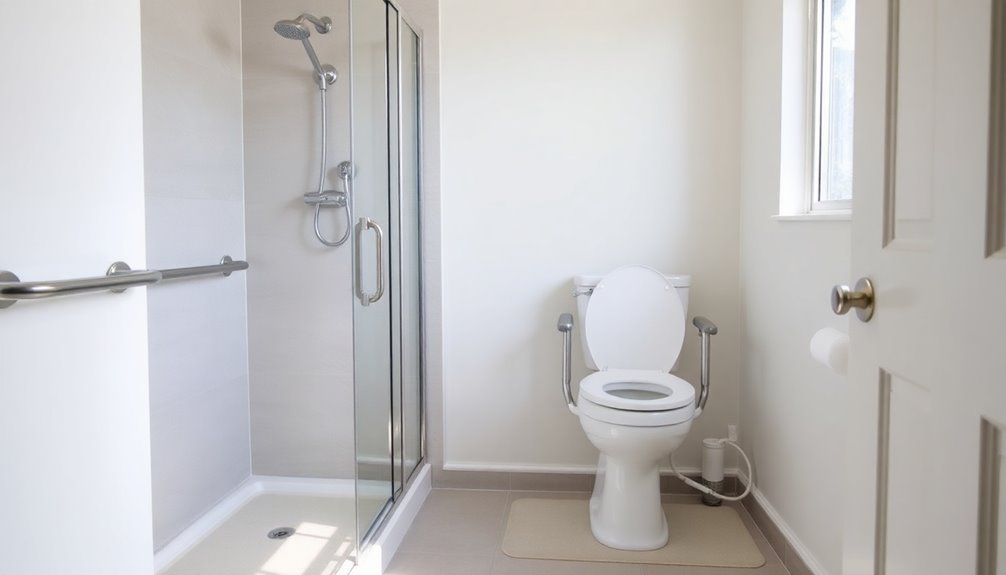
When it comes to bathroom safety, installing grab bars can make a significant difference in preventing falls.
Non-slip flooring is another essential feature that enhances stability while bathing.
Together, these elements create a safer environment and give you peace of mind. Additionally, incorporating essential oils for respiratory health can further promote a calming atmosphere, making the bathroom a more relaxing space for seniors.
Grab Bars Installation Benefits
Because falls are a leading cause of injury among seniors, adding grab bars in bathrooms can be a game changer for safety.
These simple installations provide essential support, allowing you to maintain your independence during personal hygiene routines. By reducing the risk of falls, grab bars greatly enhance your safety and well-being.
- Cut the risk of serious injury by nearly 50% during bathroom activities.
- Offer stability when entering or exiting the shower or bathtub.
- Can be custom-designed to match your bathroom's aesthetics.
- Are a cost-effective investment compared to potential medical expenses from falls.
Embracing grab bars not only promotes safety but also empowers you to navigate your home with confidence.
Non-Slip Flooring Options
Creating a safe bathroom environment is crucial for seniors, and choosing the right flooring plays a key role in that. Non-slip flooring options, like textured vinyl or rubber, can greatly reduce the risk of slips and falls, ensuring safety for the elderly.
Consider adding non-slip mats or strips in wet areas, such as shower floors and near bathtubs, to increase traction. Opt for non-glare finishes on flooring surfaces to enhance visibility and help seniors navigate their bathrooms with confidence.
Remember, it's important to select flooring materials rated specifically for wet areas, as they're designed to perform well even in moisture.
Finally, choose easy-to-clean options to maintain hygiene and prevent mold buildup, keeping your bathroom safe and welcoming.
Modifying Kitchen Spaces for Accessibility

Modifying kitchen spaces for accessibility can greatly enhance the cooking experience for seniors, making it safer and more enjoyable. By implementing thoughtful changes, you can create an environment that meets their needs.
Consider these key modifications:
- Install adjustable-height countertops for comfortable meal prep.
- Use lever-style taps and easy-to-grip cabinet handles to reduce strain.
- Incorporate pull-out shelves and lazy Susans for easier access to items.
- Guarantee adequate task lighting and contrasting colors for improved visibility.
Additionally, design your kitchen layout with clear pathways to accommodate mobility aids, allowing for safe navigation throughout the space.
These adjustments not only promote independence but also enhance overall accessibility, making cooking a pleasure rather than a chore.
Utilizing Smart Home Technology

As you explore ways to enhance your living space, utilizing smart home technology can greatly improve safety and convenience for seniors.
With voice-activated assistants, you can control lights, thermostats, and appliances hands-free, which reduces the need for physical movement and enhances safety.
Automated lighting systems, programmed to activate at specific times or via motion sensors, improve visibility and cut down on fall risks during nighttime navigation.
Smart doorbell cameras let you see and communicate with visitors without opening the door, promoting independence.
Additionally, motion-sensor alarms can alert caregivers if you fall, ensuring timely assistance.
Finally, health monitoring devices track essential signs, keeping you informed about your health and supporting your mobility needs.
Designing Outdoor Spaces for Mobility
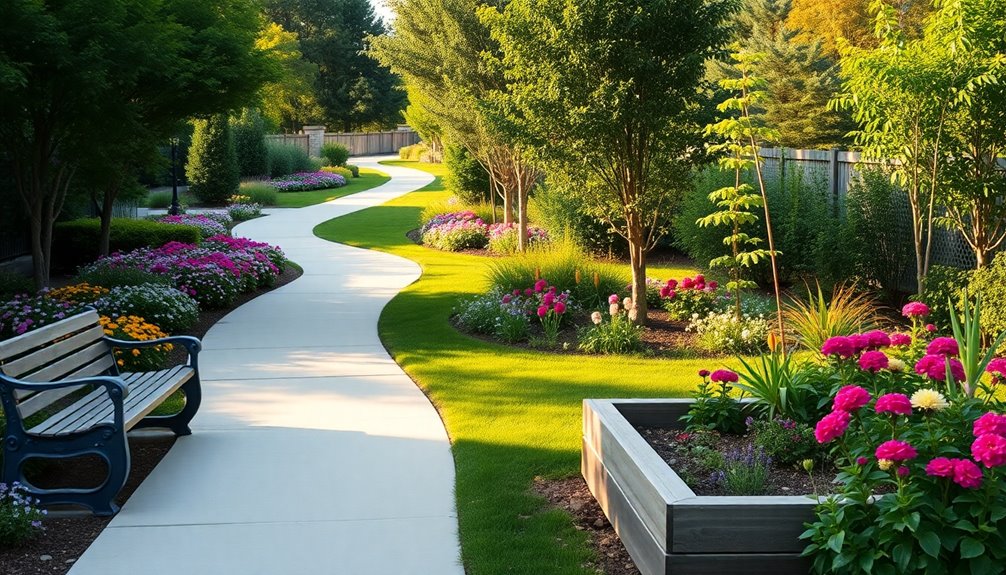
Smart home technology enhances indoor safety, but it's just as important to contemplate how outdoor spaces can support mobility. Designing these areas with seniors in mind can greatly improve their outdoor experience.
- Guarantee outdoor pathways are at least 36 inches wide for walkers and wheelchairs, using non-slip materials.
- Incorporate gentle slopes or ramps instead of stairs to ease navigation for those with mobility challenges.
- Install handrails at heights of 34 to 38 inches along pathways to provide stability and support.
- Use contrasting colors for surfaces to enhance visibility and depth perception.
Additionally, consider creating sheltered seating areas with accessible benches along walking paths, allowing seniors to rest and enjoy their surroundings safely.
Benefits of Implementing Age-Friendly Modifications
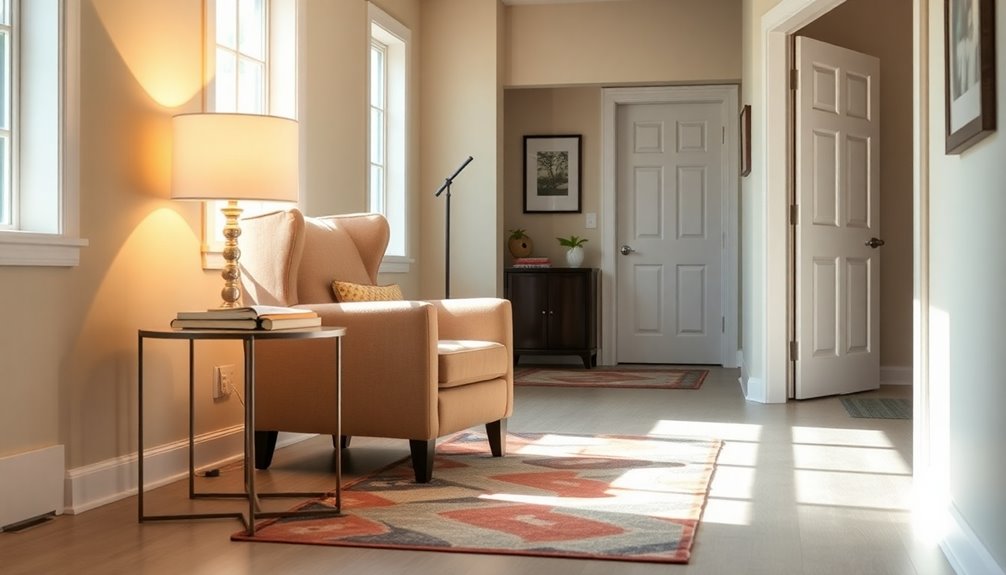
Implementing age-friendly modifications can greatly enhance the quality of life for seniors, making their homes safer and more accessible. By incorporating features like grab bars and non-slip flooring, you can considerably reduce the risk of falls, a leading cause of injury.
Wider doorways and hallways improve mobility, allowing easier navigation with walkers or wheelchairs. Adjustable-height countertops and lever-style door handles enhance accessibility, enabling seniors to perform daily tasks independently.
Thoughtful lighting solutions, such as motion-sensor lights, boost visibility and further enhance safety. Additionally, creating open living spaces with clear pathways not only promotes mobility but also fosters social interaction, positively impacting the mental well-being of older adults.
Embracing these modifications transforms living spaces into supportive environments.
Frequently Asked Questions
How to Design for Elderly People?
When you're designing for elderly people, think about their mobility needs and safety.
Start by creating zero-step entries and ramps for easy access. Make doorways and hallways wider to accommodate walkers or wheelchairs.
Use non-slip flooring in areas like bathrooms to prevent falls. Install grab bars in key spots for added support, and consider adjustable-height countertops in kitchens to make cooking easier.
These changes can greatly improve their daily experiences and independence.
What Is Inclusive Design for Older People?
Inclusive design for older people prioritizes practicality and safety, ensuring spaces are user-friendly.
You'll find features like non-slip surfaces, grab bars, and great lighting that boost confidence and reduce accidents.
Wider pathways and zero-step entries promote smooth movement, accommodating walkers and wheelchairs.
Adjustable elements, like height-adjustable countertops, cater to changing needs.
What Factors Should Be Considered in Designing Environments for Older Adults?
When designing environments for older adults, you should consider accessibility, safety, and functionality.
Guarantee there's no-step access and wider doorways for mobility aids. Incorporate non-slip flooring and adequate lighting to prevent falls.
Opt for an open layout to facilitate easy movement and minimize obstacles. Choose ergonomic furniture that offers comfort and support.
Finally, integrate smart home technology to empower independence and enhance the overall living experience for seniors.
What Is the Most Desirable Home Design for Aging in Place?
Imagine stepping into a home where every corner whispers comfort and ease.
The most desirable design for aging in place features a zero-step entry, welcoming you without stairs or ramps.
You'll appreciate wider doorways that let you glide through effortlessly, and single-story living that keeps you grounded.
Bathrooms should boast walk-in showers and grab bars, while universal design elements like lever handles make daily tasks a breeze.
It's all about creating a sanctuary for your golden years.
Conclusion
Incorporating age-friendly design can greatly enhance seniors' mobility and overall quality of life. Did you know that nearly 90% of seniors want to age in place? By making simple modifications like improving lighting and creating clear pathways, you can help guarantee their homes remain safe and accessible. Embracing these practical ideas not only fosters independence but also promotes a sense of dignity and well-being. Start implementing these changes today and make a positive impact on their lives!
